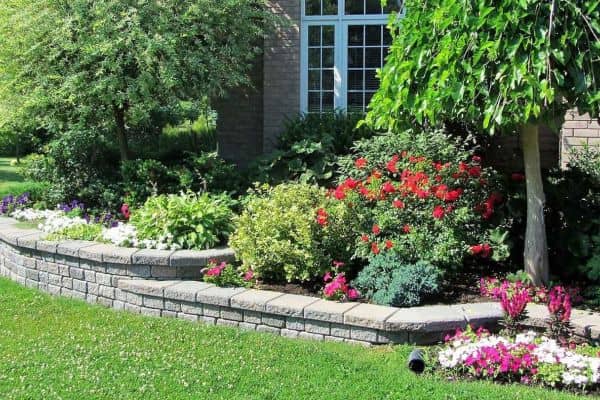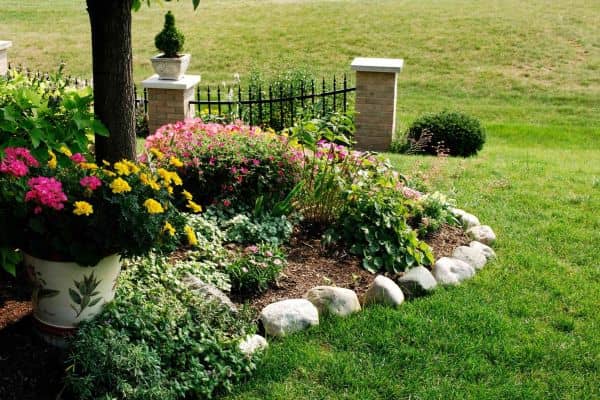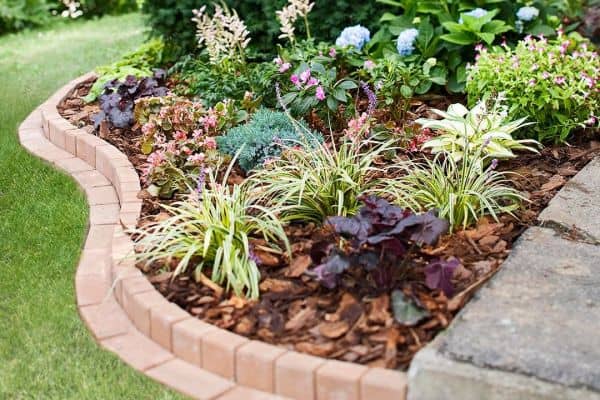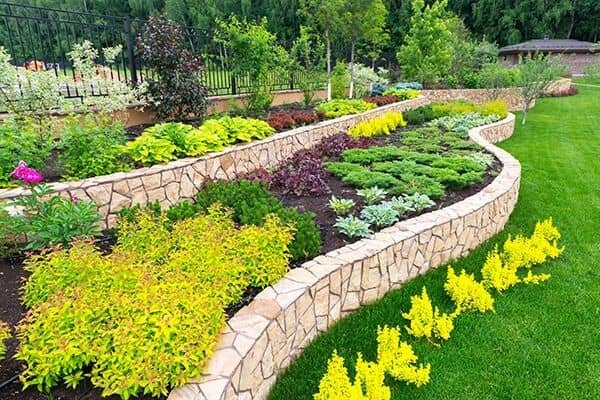Stone Flower Bed Border is one of the best ways you can decorate your home. They help a lot to elevate your house landscape a lot. So here we will be talking about building Stone Flower Bed Border ideas for your yard:
How to Create a Stone Flower Bed Border
Creating a Stone Flower Bed Border in your garden is easy if you know hoe to do them. So we will be teaching you how you can make Stone Flower Bed Border step-by-step to make your landscape beautiful:
1. Consider Your Soil Type
The first step to starting a stone border is knowing the quality of your soil by knowing its drainage, nutrient levels, and pH balance. Different flowers need different types of soil as their requirements so first you have to know the quality of your soil.
You can do the soil test and know what kind of soil your garden has and its nutrient levels and pH balance. After testing soil, you can simply select the plants that your soil will grow better on and attract pollinators when needed.
2 Choose the Best Plants
After you have tested and know your soil drainage, nutrient levels, and pH balance then you can choose which plants you want to plant in your garden. You can select the plant you want in your garden and don’t forget to consider their sunny position, soil type, and moisture levels so they can grow properly on your stone border.
Also, don’t forget to choose plants that will look better on your landscaping more look for their size, style, and environmental conditions so they can grow healthy in your garden.
3. Mark Out the Area
After testing soil and choosing plants for your garden you can proceed to mark out the areas where you want the stones and plants to go. The marking involves things like outlining the perimeter of the area where you want to add the border, including any curved edges.
Remember to measure properly and ensure the border alignment and size for your desired landscape design. Measure and mark all the garden border edging, including any curves or irregularities properly to achieve the desired shape and size for you.

4. Dig the Trench
After you have measured and marked the area properly then you can use a shovel or trenching tool to dig around the marked area where you want stones to go. Remember to dig properly so the stone’s size and thickness go properly.
While digging the trench don’t forget to remove rocks or debris from the trench and dig the depth concerning the roots of plants that you will be planting inside the border.
5. Place the Weed Membrane
Placing the weed membrane is also important or the borders will be filled with unwanted weeds and plants. You will have to lay down a layer of weed membrane before you place your stones on the edge of the landscape.
Use a high-quality weed membrane so they will do their job properly and make sure to overlap the edges of the weed membrane.
6. Place the Stone Edging
Now all you have left is to place a stone edging in your landscape. You will have to place the stone carefully edging the position and making sure that the stones are leveled properly and fit snugly against each other.
Do not forget to choose the style of the stones and the most appropriate size you need for your desired landscaping design. You can also use a rubber mallet and leveler to adjust properly and use soil or gravel to fill the gaps of your stones with each other and ground.

Natural Stone Landscape Edging Ideas
There are a lot of things and items you can use for landscaping edging but with a lot of options, it may be hard to decide which stone you want to use to build a Stone Flower Bed Border. So here we will be talking about the main types of stones you can use to edge your landscape:
1. Natural Boulder Stone
Natural boulder stones are one of the popular choices in garden edging as they are durable, versatile, and have natural beauty. They can provide a lot of benefits on your garden edging journey some of them are as follows:
Natural boulder stone is a popular choice for garden edging due to its. This type of natural stone border edging can provide a variety of benefits that include:
- Natural boulder stone is one of the durable materials which last in garden edging for years and it can even withstand exposure to light and water a lot with a high durability.
- Natural boulder stone is a low-maintenance stone that is easy to clean, environment friendly and helps to keep your garden maintaining its beautiful look with attractive, aesthetic, and friendly outdoor space.
- Natural boulder stone is available in a wide variety of sizes and shapes which makes it a versatile option for garden edging designs as the garden edging requires a lot of different sizes and shapes to give the border from simple borders to more complex rock gardens and retaining walls.
2. Decorative Chipping Edging
Decorative chipping edging can provide a lot of benefits on your garden edging journey some of them are as follows:
- Decorative chipping edging is one of the easiest materials to install during garden edging as it helps those who have limited time and resources.
- They also help a lot to plants to grow properly as Decorative chipping edging provides proper drainage and prevents water from pooling around your plants.
- Decorative chipping edging can also be used in different landscaping ideas rather than only garden edging some of them are pathways, rock gardens, and raised garden beds.
- They are one of the stones for garden edging that are available in different colors and textures of variety to provide your garden with endless possibilities for customization and creativity.

3. Caged Rocks (Gabion Walls)
Caged Rocks also known as Gabion Walls can provide a lot of benefits on your garden edging journey some of them are as follows:
- Caged Rocks are one of the most flexible stones that can be used for a variety of landscaping designs.
- They have exceptional strength and can withstand any type of harsh weather conditions with foot traffic.
- Caged Rocks or Gabion Walls can shift or move once they are installed which helps them to provide added stability and safety to your garden edging.
4. Pebble Edging
Pebble Edging can provide a lot of benefits on your garden edging journey and they are also great for small gardens some of the benefits are as follows:
- Pebble Edging requires a lot less minimal upkeep than other options.
- Like Decorative chipping edging, they are also available in different colors that can enhance your landscape.
- Pebble Edging not only enhances the landscape but also helps your garden soil regulate temperature, promotes healthy plant growth, and reduces the need for additional watering.
- Pebble Edging also helps to create a seamless and natural transition between your lawn and garden.
FAQs
Q. What Stone is Best for Flower Beds?
River Rock, Lava Rock, Crushed Stone, and Pea Gravel are some of the best stones for flower beds in your front yard and back yard.
Q. How to Line a Flower Bed with Stone?
To line a flower bed with stones you will have to dig a 2- to 3-inch-deep trench along the stones and plant flowers near to stone to line up with stones properly.
Q. What is the Cheapest Rock for Flower Beds?
Pea gravel, river rocks, and crushed concrete are some of the cheapest rocks available for flower beds.
Also Read: How to Grow and Care for Goldfish Plant! Know Its Types, Propagation Tips, and Diseases!
